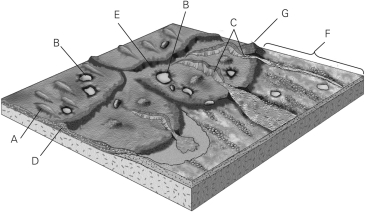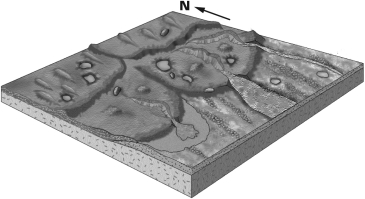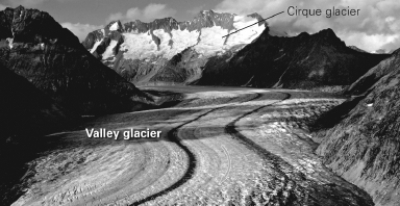A) a
B) b
C) c
D) d
Correct Answer

verified
Correct Answer
verified
Multiple Choice
Moraines are composed of jumbled piles of very poorly sorted rock fragments ranging in size from boulder to clay that fall out near the edges of glaciers.Why are the larger particles (boulders,etc.) not broken down during transport in the glacier?
A) because the ice is not strong enough to break up rock
B) because sediments are picked up and carried along with the ice as it moves
C) because the sediments are not carried for very long distances
D) because the ice stops the chemical weathering processes
Correct Answer

verified
Correct Answer
verified
Multiple Choice
Identify the area where layered sediments have been deposited in the figure below. 
A) E
B) C
C) A
D) F
Correct Answer

verified
Correct Answer
verified
Multiple Choice
The Milankovitch cycles describe the change in ________ because of changes in the ________ of Earth relative to the Sun.
A) greenhouse gases;tilt
B) eccentricity;orientation
C) albedo;precession
D) solar insolation;orientation
Correct Answer

verified
Correct Answer
verified
Multiple Choice
A(n) ________ in eustatic sea level is ultimately the result of a ________ event.
A) increase;global cooling
B) increase;local uplift
C) decrease;subsidence
D) decrease;global cooling
Correct Answer

verified
Correct Answer
verified
Multiple Choice
A glacier will always advance from its source area if the rate of accumulation is greater than the rate of ________.
A) subsidence
B) erosion
C) ablation
D) uplift
Correct Answer

verified
Correct Answer
verified
Multiple Choice
A hanging valley is formed when a ________.
A) smaller glacially carved valley intersects with a larger glacially carved valley
B) smaller stream-cut valley intersects with a larger stream-cut valley
C) smaller stream-cut valley intersects with a larger glacially carved valley
D) stream-cut valley is on the upthrust side of a normal fault
Correct Answer

verified
Correct Answer
verified
Multiple Choice
Using the figure below,identify which way the glacier advanced. 
A) north
B) south
C) east
D) west
Correct Answer

verified
Correct Answer
verified
Multiple Choice
What types of moraines are shown in the figure below? 
A) medial moraines
B) terminal moraines
C) lateral moraines
D) recessional moraines
Correct Answer

verified
Correct Answer
verified
Multiple Choice
Glacial ice cores can be used to determine the atmospheric concentration of CO₂ during Earth's history.How do scientists come up with these data?
A) They use the thickness of the ice layers to determine how much CO₂ was in the atmosphere.
B) The melt the ice and measure how much carbon was trapped in the ice.
C) They record changes in the shape of ice crystals to determine the paleoclimate.
D) They break the ice apart,release the air trapped in bubbles,and then measure the gases.
Correct Answer

verified
Correct Answer
verified
Multiple Choice
By increasing the albedo of Earth,global ice sheets produce conditions that are ________ to their further advance,thus providing an example of ________ feedback.
A) detrimental;positive
B) detrimental;negative
C) favorable;positive
D) favorable;negative
Correct Answer

verified
Correct Answer
verified
Showing 41 - 51 of 51
Related Exams